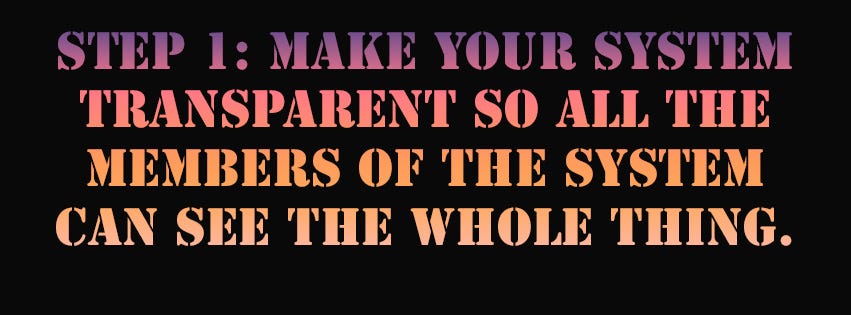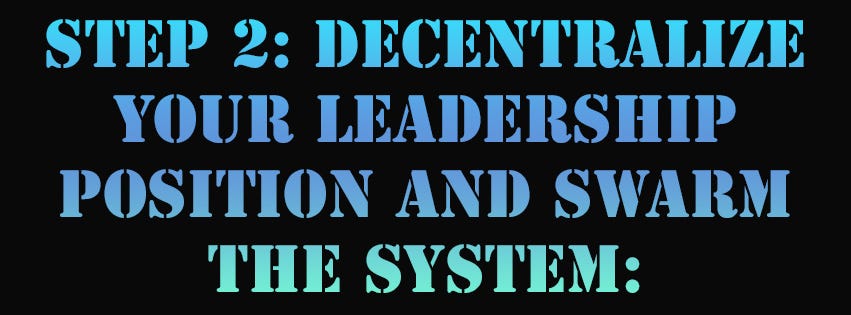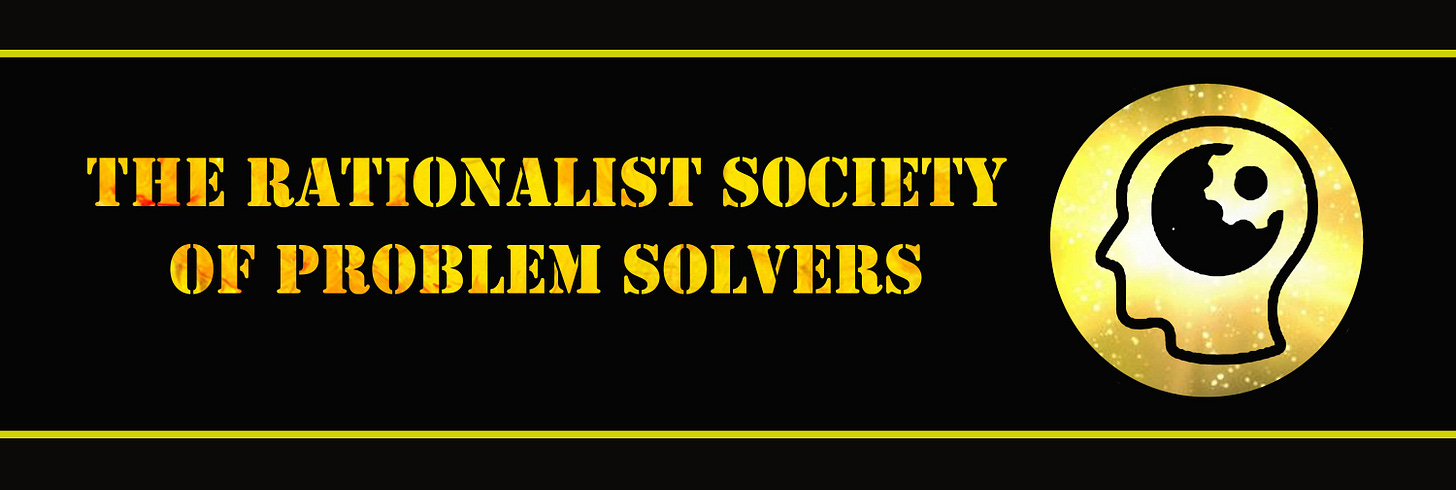Fix Any Business using Human Swarm Intelligence
Also you can solve the principal-agent problem with Transparency, Decentralization, and The Wisdom of Crowds
Imagine if by knowing one technique, you could walk into almost any business (or any other system including nonprofits, governments, and more), take control of it, and be able to run it at an optimum level for all of the people inside the system.
It is easiest to explain using a business as an example. So, here is a simple formula almost any business with employees could use. It uses ‘Human Swarm Intelligence’ to guide the business. If you are unfamiliar with that term, we suggest reading this article first. But basically it means this - use your employees like a magic 8-ball, ask them questions, and try to harness the collective wisdom of the swarm. Problem-solve the business together as a group. A “swarm” is simply a group of people that can give one answer, and there are several methods to aggregate it.
Even though it is coming, you do not need to wait for better innovations in Human Swarming software to start fixing your businesses right now (although when it does come out it will certainly be helpful). For now, you could simply use digital polling and voting methods - or even pen and paper methods - to start to turn your business around and start harnessing the wisdom from the crowd right away.
Simply put, if you run any system of people that you have authority over in a traditional top-down centralized manner, then you can try this formula.
Formula:
Make your system(s) radically transparent.
Decentralize your leadership position by swarming the system and harnessing the wisdom of the crowd.
So let’s break down what this means.
Step 1: Make your system transparent so all the members of the system can see the whole thing.
It would seem most people would think transparency is a weakness in business, but it is not. It is a strength. Vulnerability builds trust, and trust with your employees (and customers) is vital to a good swarmed system. If you trust each other - like a SEAL Team - then you can maximize your collective intelligence together, and use the power of the group to help problem solve nearly any problem better than you would have alone.
Being transparent is not easy for many leaders. For one, many are corrupt - or many businesses are doing unethical behaviors. For two, ego often gets in the way. Most leaders think that if they ask for help instead of dictating commands, they will not be respected. This is far from the truth. People in all systems want to feel like they are part of something bigger than themselves. People also want to feel like their voice is being heard, which is the fundamental attribute of swarming. This builds a close-knit highly aligned atmosphere which in turn builds a kind of super-strength inside the business. It also develops respect back onto the leader(s) for having the wisdom and courage to try this.
One of the most common reactions from people who have been part of a successfully swarmed system is this: a deep feeling of purpose and cohesiveness. In a business this can be further amplified if the members get compensated based on how the overall business performs. And, since the business is transparent, we highly recommend doing this. If the individual people benefit when the systems does, this allows everyone to experience joy and growth together. Pay structures seem to work best in these transparent systems when they are bonus based or goal based. This way it gamifies success for the entire swarm.
Also, when the ideas percolate from the bottom up, the people inside the systems care more. They will defend new rules, ideas, and risks as if they were their own — because they were their own. This is one of the hardest problems to solve in any business - the principal-agent problem. That is, getting the agents - the employees - to care as much as the principal -the owner. In a properly swarmed business, this problem gets solved with transparency, with letting everyone help problem solve as a group and have their voice heard, and also by compensating based on group outcomes.
Without transparency in the system there is another problem. If everyone cannot see the truth then they cannot see the problem in order to solve it. The businesses who hide the truths from their employees are blocking themselves from being able to problem solve as a swarm. In the recent past, we have seen successful systems so transparent the owners shared with everyone the truth on profits and losses, ownership payouts, goals, wages, bonuses, taxes, and more. By letting everyone that is part of the business feel like what it is to own the business, the ability to harness wisdom from the crowd becomes amplified.
Of course, some innovations and parts of the business like “trade secrets” need to be carefully monitored and can’t always be shared carelessly. The most important part of the formula is sharing with the people who have skin in the game - the employees who are problem solving with you. Over time you will see that secrecy from competition isn’t as important as harnessing the wisdom that exists when you bring many minds together to solve the problems.
Trust between people is earned through vulnerability and iterations. But trust in a system is just this one thing: Transparency. The more transparent, the more trust. Trust fuels collaboration. Collaboration fuels innovation. Having the courage to be transparent is the first step in fixing any business that isn’t doing well.
One more thing about transparency. Customers love transparency. They are way more likely to be forgiving if you make a mistake when everything is transparent. Think about it from the perspective of a customer. Let’s say a company opens up that is exactly the same as Amazon - same prices, goods, and service. The only difference is they are 100% transparent. The new company shows how much all the employees are making. They show you their profits, what they do with the money - do they make better communities? Do they help give back to the environment? They show openly how they listen to their employees in think tanks and swarms and help create new ideas together. They show that they follow the five pillars of an ethical business (more on this later). Now as a customer, where are you spending your money? With the centralized and non transparent Amazon so Bezos can buy another half billion dollar yacht? Or the new competitor that is transparent and shows you all the good that the business is doing in the market and beyond?
It turns out that being transparent is a special competitive power that corrupt businesses cannot wield, that ethical swarm-run business can use to their advantage.
Step 2: Decentralize your Leadership Position and Swarm The System:
Previously, we wrote an article about how The World Needs Courageous Leaders to Decentralize Themselves. This really starts with the ego. Whoever is in charge of the system must set their ego aside and start to listen with brutal honesty to the people inside the system. There are many ways to do this. Swarming software that can aggregate one answer from a large crowd is ideal, but you can start cheaper. Pass out questionnaires. Ask the employees what they would do in your position. Ask broad sweeping questions that invoke imagination. Ask questions that will help you understand your role better - even if your ego is bruised along the way. Having a boss who decentralizes their own leadership is almost as rare as having a business that is transparent. But combining them, becomes a super power. Have the guts to ask questions, admit you don’t know everything, and problem solve as a team.
Also, if the business is large enough, break it up into smaller swarms, usually by departments. Use questionnaires or software to extract information from your employees and staff. Aggregate those answers. Then allow the group to vote (or digitally swarm) on what ideas should be implemented first. Rank choice voting seems to work well here too. But software like Unanimous AI is the current best for any business with 250 or less employees (although it is a little pricey).
If you are skeptical, that’s understandable. Dig deeper into the results. Or better yet, start off slow and just try it a little and see your own results. It has been proven over and over that crowds who understand the problem can solve it much better than individuals or even experts. So why are businesses so reluctant to act and listen to their employees?
If your business or department is struggling, we implore you to try this and report back to us with results.
Here are a few additional tips that have seen success in the real world with swarming businesses:
1) Set a code and a purpose for your system. Do more than just make money. Being transparent is much easier if your business adheres to the 5 pillars of an ethical business. Strive to take care of the following 5:
Your customers - without them the business does not exist. Do not rip anyone off. Stand behind your products and services. Make right any mistakes. Innovate.
Yourself (the business) - if the company isn’t making money it helps no one. A profitable company can contribute positively to its employees, customers, and the community.
Your employees - The business is the employees. Taking care of them should always come before taking care of the ownership group. A truly ethical business should be proud of how much their employees make
The community - Go beyond profit-driven motives by actively engaging with the community. Contribute to local initiatives, participate in charitable events, or undertake projects that benefit the community, such as volunteering for cleaning up the park or beyond.
The Environment - Minimize environmental impact by adopting practices that do the least harm, within reasonable bounds.
2) Keep the free flow of information in your system sacred. If you want to harness the wisdom of crowds, communication is key.
3) Skin in the Game. In a business swarm most people have a vested interest in seeing the swarm succeed. Swarming in general seems to work better when the people in the swarm have something to lose.
4)Be focused on compound interest and relationships. Strive for long term success instead of short term. When you build trust in your systems you solve the iterated prisoner’s dilemma better than tit-for-tat. You solve it before there is ever a dilemma.
In our next article, we will explore the concept of using a swarm to interview an individual who has achieved significant success by leveraging the wisdom of the crowd to manage businesses. But what does this entail exactly? We plan to select 10-20 participants from our problem-solving group, form a small swarm, and employ existing Human Swarm Intelligence technology to generate optimal questions for the interview. Essentially, the swarm itself will be responsible for posing the questions.
Envision expanding this approach on a grander scale—introducing the concept of Swarm Journalism. Picture a podcast or TV show where guests face interrogation by a swarm consisting of potentially millions, or even billions, of individuals. This could involve scenarios where a city, such as Cleveland, seeks answers from its newly elected mayor, or where influential figures like Presidential candidates or business magnates like Bill Gates or Larry Fink respond to the top ten questions posed by a swarm of four billion people.
Fascinating, isn't it?
Moreover, should any of these figures attempt to evade the swarm and sidestep questions, imagine the impact of one million or one billion people simultaneously calling them out for their perceived avoidance on social media platforms. Swarm journalism also presents opportunities for application in debates. Rather than relying on centralized and potentially biased entities like the CPD (Commission on Presidential Debates) or major news networks, a swarm could assemble just before debates to generate challenging and unbiased questions in a decentralized manner. Swarms are likely to pose much tougher and more intriguing questions than traditional debate organizers.
Consider the scenario where we inform figures like "Mr. Trump," "Mr. Biden," "Mr. Gates," or "Mr. Musk" that these are the top questions from a swarm of 200 million Americans, and request them to respond. Notably, these questions could be generated almost instantly, likely within an hour, preventing politicians from preparing rehearsed responses.
Human Swarm Intelligence has so many fascinating possible uses. For billions of years there were only single celled organisms on this Earth, then one day they started working together to form multi-celled organisms like me and you. The next evolution for humanity is the same.
Thanks for reading!
Coming soon: SwarmAcademy.ai
As always the entire purpose of The Society of Problem Solvers is to connect with other solutions-minded results-driven people like yourself!
Thank you to all of the writers that make this possible. We are always accepting guest writers, so if you have an idea for a solution, please reach out. Let’s solve it all, together.
For over 3 billion years on this planet there were only single-celled organisms. Then one day they somehow learned to work together and make complex multi-celled creatures . Right now we are like those single-celled organisms. Our next evolution is finding how to work together, better… (like we wrote about here).
#SwarmAcademy #ResultsMatterMost #DecentralizeEverything #DemandTransparency
COMMENTS ARE FOR EVERYONE AS A PLACE TO THINK-TANK SOLUTIONS. They will never be for paid-only subscribers and we will never charge a subscription.






Transparency is a weapon for those with a system good enough to be so.
Yes! This is exactly what good leadership looks like in the corporate world. Been at it for decades.. however not every corporate culture is open to change.